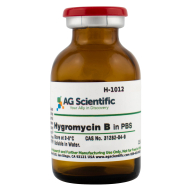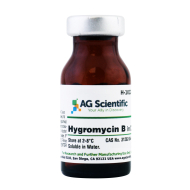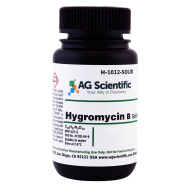AG Scientific emerged as a leading manufacturer and importer of Hygromycin B, an antibiotic used for gene selection. Over the past 20+ years we have learned a lot about this aminoglycoside antibiotic. It was our success with a combination of fermentation & synthesis that has allowed us to build a customer base of researchers and catalog biochemical distributors worldwide. Questions on solution storage and the procedures to determine toxic concentrations are common, so here we provide answers to frequently asked questions we have received from our customers.
Many researchers are foregoing searching for new antibiotics and have instead turned to older antibiotics, which for various reasons never reached clinical applications. Acting as an ally to researchers worldwide, AG Scientific has emerged as a leading supplier of high-quality Hygromycin B, an antibiotic used for gene selection.
Product Availability
Bulk and custom orders available!
SKU |
Product |
| H-1012-DI | Hygromycin B in DI Water |
| H-1012-SOLID | Hygromycin B Solid, High Purity, Cell Culture Tested |
| H-1012-MU | Hygromycin B, Concentrated Solution |
| H-1012-PBS | Hygromycin B, High Purity in PBS Buffer |
About Hygromycin B
Description
Hygromycin B is an aminoglycoside antibiotic produced by Streptomyces hygroscopicus. It is used for the selection and maintenance of prokaryotic and eukaryotic cells transfected with the hygromycin resistance gene, hph. Hygromycin B kills bacteria, fungi and higher eukaryotic cells by inhibiting protein synthesis. The resistance gene codes for a kinase that inactivates the antibiotic through phosphorylation. Cloning of the resistance gene and fusion with eukaryotic promoters has resulted in the development of vectors that permit selection for resistance to Hygromycin B in both prokaryotic and eukaryotic cells.
Identifiers
CAS: |
31282-04-9 |
PubChem CID: |
35766 |
ChemSpider: |
32900 |
RTECS: |
WK2130000 |
Frequently Asked Questions
What is the stability of Hygromycin B in solution?
The antibiotic is stable for at least 2 years at 4°C. It is stable for about one month at 37°C.
What color is the solution?
The color can vary from light-yellow to dark-brown or caramel. The concentrated solution tends to have a darker appearance.
What is the working concentration for selection?
The working concentration for the purpose of selection varies with cell type, media, growth conditions and cell metabolic rate. Recommended concentration for the selection of resistant cells is 25-1000 ug/mL. Commonly used concentrations for selection are 200 ug/mL for mammalian cells, 20-200 ug/mL for plant cells & bacteria cells and 200-1000 ug/mL for fungi. Your optimum concentration should be tested experimentally.
How can non-transfected cells escape antibiotic selection?
Cells can escape selection if the antibiotic concentration is too low or if the cell density on the plate is too high. Additionally, cells that rapidly proliferate are killed faster than those that proliferate slowly. Control cells should die within 5-7 days after the addition of the antibiotic, allowing colonies of resistant cells to form by 10-14 days.
How do I determine the toxic concentration?
Hygromycin B is added to the culture medium at a concentration that varies with the cell type transfected. A titration experiment for each cell type may therefore be performed to determine the amount of Hygromycin B needed to kill non-transfected cells. The working concentration for mammalian cell selection is normally between 50 ug/mL and 1 mg/mL, Plant cells: 20-200 ug/mL, Bacteria: 20-200 ug/mL and Fungi: 200 ug-1 mg/mL. Your appropriate concentration should be tested experimentally.
How do I perform a dose response curve?
To determine the minimum concentration of antibiotic required to kill your non-transfected host cell line:
-
Test ranges of concentrations (5-6) to ensure that you determine the minimum concentration necessary for your cell line.
-
Seed cells at approximately 20-25% confluency on the appropriate number of plates for each time plate and allow cells to adhere overnight. For cells that require higher densities for viability, increase the number of cells seeded.
-
The next day, substitute culture medium with medium containing varying concentrations of the antibiotic.
-
Replenish the selective medium every 3-4 days.
-
Count the number of viable cells at regular intervals to determine the appropriate concentration of antibiotic that prevents the growth of non-transfected cells. Select the concentration that kills the majority of the cells in the desired number of days (usually 7-10 days).
How do I maintain Hygromycin-resistant phenotype of transfected cell lines?
To maintain Hygromycin-resistant phenotype of transfected cell lines and for the elimination of revertants, cells may be regularly cultured in medium containing Hygromycin B at the same concentration used for the initial selection.
When is replacement of media required?
Replacement of the culture media containing Hygromycin B is needed only if nutritional components are consumed by the cells cultured. Acidification of the culture medium is normally a sign of consumption. Utilizing phenol red or media containing phenol red will aid in the detection of acidification. In this case, the media will turn yellow.
Is Hygromycin B sensitive to acids?
It is sensitive to high concentrations of acids, however a brief a exposure to dilute acids does not affect its stability.
Can we increase the sensitivity of our cells to the antibiotic?
The sensitivity to Hygromycin B can be increased by increasing the pH of the medium. Sensitivity appears to be greater at lower salt concentrations.
What enzyme inactivates Hygromycin B?
Hygromycin phosphotransferase (hpt) inactivates the antibiotic through phosphorylation. The hygromycin phosphotransferase gene (hpt, hph or aphIV) codes for hygromycin phosphotransferase, and is utilized as a selectable marker gene for both plant and animal systems.
What is Hygromycin B’s mode of action?
The compound binds to the 30S ribosomal subunit and affects the fidelity of translation.
How can I roughly assess the compound’s purity?
The color of a Hygromycin solution is a good indicator: the clearer it is, the purer. Therefore, caramels to brown colored solutions are of inferior grade. The color difference may not be very dramatic with a freshly-made low concentration hygromycin solution.
What is the spectrum of inhibition?
An aminoglycoside antibiotic that inhibits protein synthesis in bacteria, fungi, and higher eukaryotes. Spectrum also stated as Gram (+), Gram (-) bacilli aerobes and facultative anaerobes.
Is Hygromycin B hazardous?
Yes. It is considered a toxic and hazardous material. Care should be taken to avoid contact with skin and eyes. Please consult and review Material Safety Data Sheet (MSDS) prior to handling.
Additional Reading about Hygromycin B
-
Hygromycin B: Selective Properties
-
What Can Be Done to Fight Antibiotic Resistance?
-
Gene Editing for Cystic Fibrosis



